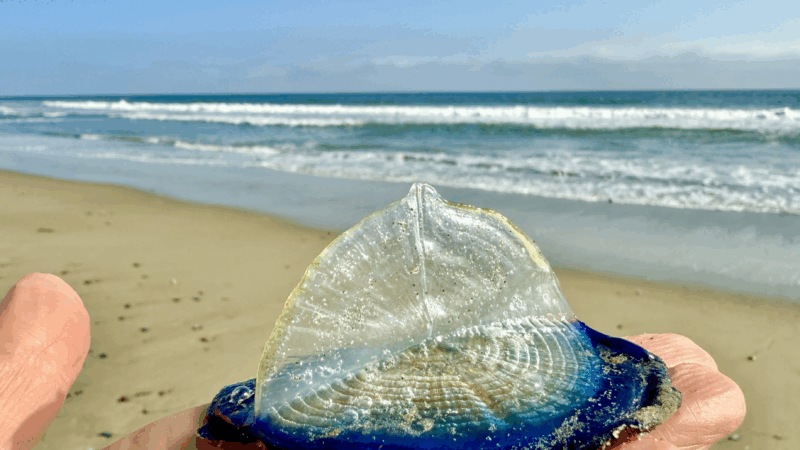Glittering blue creatures are washing up on California beaches. Here’s why
California beaches have been the site of some ghastly scenes this year. Dying sea lions, dolphins, seagulls, pelicans and even a minke whale have washed up on the sands from San Diego to Santa Barbara.
But lately, beachgoers have been treated to a beautiful marine life wonder: Hundreds of thousands of glittering Velella velella, also known as by-the-wind sailors, sea rafts, purple sails and little sails, have washed ashore up and down the California coast.
The small creatures look like oval mini-sailboats that can grow up to 4 inches long. Their gelatinous bases can range in color from vibrant blue to deep purple, and they have transparent triangular “sail” on top. It’s what allows them to be blown across the surface of the open sea where they typically live — and with strong enough winds, onto coastal sands.
“They looked like blue diamonds strewn across the beach. It was like these gems, and they’re so brilliant blue,” Emily Scher gushed over a phone interview with NPR.
Scher, a professional photographer, lives in Malibu and recently came upon tens of thousands of velella while on a sunset bike ride from Zuma to Broad beaches — a stretch of more than a dozen miles. She captured the little beauties with her camera.
“It was like a carpet. I’ve never seen so many. And so I thought, wouldn’t it be cool to get a shot with Point Doom in the distance? So I took one of those,” she said.
Indeed, the photo, a close-up of a single velella gently cupped in Scher’s hand, is cool.
“It almost looks like a fingerprint when you look at it up close,” Scher said of the Velella’s, plastic-like sail.

Though they may be new to some, it’s expected for rafts of the floating creatures to show up on the shore at this time of year.
It’s part of the spring transition, Matthew Bracken, professor of ecology and evolutionary biology at the University of California, Irvine, told NPR.
In the winter months, the wind along the U.S. west coast typically blows from the south, but in April, the prevailing wind direction shifts from northward to southward, and that shift leaves huge numbers of Velella beached along the shoreline, Bracken explained.
“It’s almost like a wave that starts in the north and moves toward the south as the system transitions to predominantly onshore-type winds. And when that happens they get blown and then they get stranded,” Bracken said.
Velellas are related to sea anemones, corals, hydroids and jellyfish. But unlike the latter, they can’t swim and don’t have enough propulsive ability to control their direction, Bracken said.
They are also closely related to, and often mistaken for, Portuguese man o’ war because of their bright blue color. But velellas are nowhere near as dangerous to humans as their larger cousins. While both use dangling tentacles to feast on their prey, the velella’s stinging cells (called nematocysts) are harmless to humans, though they can be irritating.
Bracken suggests avoiding touching your face or eyes after handling them because the stinging cells can transfer to your hands. “And if you were to rub one in a really sensitive area, that could potentially cause itching or burning,” he cautioned.
(When asked about her own reaction to holding velellas, Scher said she didn’t experience any discomfort.
“It just feels like you’re just picking up something a little bit gooey,” she said.)
Bracken noted that the “wild thing” about velella is that what is perceived as a single animal is actually a “large colony [of hydrozoa] with a whole bunch of individuals, each specialized to a different purpose.”
“Some of them are feeding individuals, some of them form the sail” others are in charge of reproduction, Bracken said.

(Nicolas Tucat | AFP via Getty Images)
Once they wash up, beachcombers only have a few hours to enjoy their colorful display. They begin to dry out and decompose as soon as they’re out of the water. Their vivid hues disappear, leaving behind piles of plastic-like, crunchy remnants.
Bracken is intrigued by recent research suggesting that there could be a connection between the mass strandings of velella and the ocean’s rising temperatures.
“There are records of these strandings stretching back as long as people have been walking and poking along the shoreline,” he said. “Some years are big years. Some years we don’t see as many of them. But when we take a step back and look at the long-term pattern, there seems to be a relationship between stranding events and sea-surface temperatures during the previous winter.”
Emily Scher said that after posting her photos to her Facebook page, several people remarked that the velella’s appearance was a harbinger of global warming. But after living in Malibu for more than 20 years, she views this year’s arrival of the iridescent creatures as a good thing.
“People were saying this means that they’re dying because of the [algae] toxins,” that have been killing marine mammals and birds, Scher said. “But I think it just means there’s a giant crop of them that were thriving and doing great.”
Tributes, not politics, play center stage as Trump hosts the Kennedy Center Honors
President Trump said he was closely involved with picking the honorees, and on Sunday he became the first president to host the Kennedy Center awards ceremony.
Thailand launches airstrikes along border with Cambodia as tensions reignite
Both sides accused the other of breaking a ceasefire that halted fighting earlier this year. Longstanding border disputes erupted into five days of combat in July that killed dozens.
Rafael Ithier, a legend of salsa music, dies at 99
The pianist, composer and arranger spent more than six decades turning El Gran Combo into one of the premier salsa institutions of Latin America and beyond.
Light from satellites will ruin majority of some space telescope images, study says
Astronomers have long been concerned about reflections from satellites showing up in images taken by telescopes and other scientific instruments.
Defense Department is reviewing boat strike video for possible release, Hegseth says
In a speech on Saturday, Defense Secretary Pete Hegseth defended the strikes, saying: "President Trump can and will take decisive military action as he sees fit to defend our nation's interests."
Bama, Miami in, Notre Dame out and Indiana No. 1 in College Football Playoff rankings
Nobody paying attention for the past 24 months would be surprised to see Indiana – yes, Indiana – leading the way into this year's College Football Playoff.









